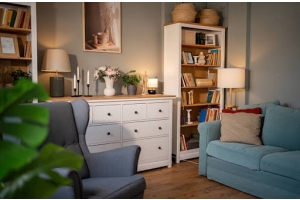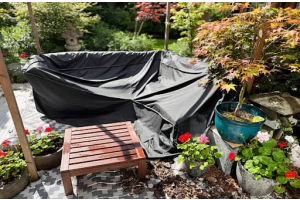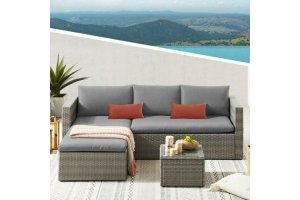
When it comes to selecting outdoor furniture for your lawn, garden, or garage, the choice of material plays a critical role in determining not just the aesthetics but also the durability, maintenance, and overall longevity of your investment. With a myriad of options available in the market, it's essential to delve deeper into the characteristics of each material to make an informed decision. In this detailed guide, we'll examine five popular materials for outdoor furniture—Teak, Aluminum, Wicker/Rattan, Powder-Coated Steel, and Polywood—and thoroughly evaluate their suitability based on various factors, including durability, price, movability, water resistance, sun protection, recyclability, and aesthetics.
Factors to Consider While Choosing Outdoor Furniture Material:
Choosing the right material for your outdoor furniture is crucial to ensure it withstands the elements, fits your lifestyle, and enhances your outdoor living experience. Here are the key factors to consider before making a decision:
- Durability: Outdoor furniture is exposed to various environmental factors such as sunlight, rain, humidity, and temperature fluctuations. Select a material known for its durability and ability to withstand outdoor conditions without deteriorating quickly.
- Weather Resistance: Consider the climate in your area. Choose a material that can withstand the specific weather conditions prevalent in your region, whether it's intense sunlight, heavy rain, strong winds, or extreme temperatures.
- Maintenance Requirements: Evaluate the level of maintenance required to keep the furniture in good condition. Some materials may require regular cleaning, sealing, or refinishing, while others are more low-maintenance and only need occasional care.
- Aesthetics: The style and aesthetic appeal of the furniture should complement your outdoor space and reflect your personal taste. Consider the design, colour, and texture of the material to ensure it enhances the overall look of your patio, garden, or deck.
- Comfort: Comfort is essential, especially for furniture used for lounging or dining. Consider factors such as cushioning, ergonomic design, and the overall feel of the material to ensure optimal comfort and relaxation.
- Price: Set a budget and compare the prices of different materials to find an option that fits within your budget while still meeting your requirements for quality and durability.
- Weight and Movability: Consider the weight of the furniture and whether you'll need to move it frequently. Lightweight materials are easier to move around but may sacrifice stability, while heavier materials offer more stability but are harder to relocate.
- Space Constraints: Take into account the size and layout of your outdoor space. Choose furniture that fits comfortably within the available space and allows for easy movement and circulation.
- Environmental Impact: Consider the environmental sustainability of the material. Opt for eco-friendly options such as recycled or renewable materials, and choose manufacturers with sustainable practices and certifications.
10.Longevity: Invest in furniture that will stand the test of time and provide years of enjoyment. Look for materials with a reputation for longevity and durability, backed by warranties or guarantees from reputable manufacturers.
By carefully considering these factors and weighing the pros and cons of each material, you can choose outdoor furniture that not only meets your practical needs but also enhances the beauty and functionality of your outdoor living space for years to come.
1. Teak:
Teak is a premier choice for outdoor furniture due to its exceptional durability, making it a long-term investment for outdoor spaces. Its natural oils and tight grain structure render it highly resistant to moisture, rot, and pests, ensuring longevity even in the face of harsh weather conditions. While the initial cost of Set Solid Teak Wood may be higher than that of other materials, its resilience and minimal maintenance requirements often justify the investment over time. Additionally, teak's weight provides stability to furniture pieces, although it may limit their movability compared to lighter materials. Despite its weight, teak furniture can still be relocated with some effort. Moreover, teak's innate resistance to water damage eliminates the need for additional waterproofing treatments, simplifying maintenance routines.

Furthermore, teak's natural properties also offer excellent sun protection, maintaining its colour and integrity over time with minimal fading. Its timeless aesthetic appeal adds to its allure, as the wood gracefully weathers to a beautiful silvery patina over time. While teak is not inherently recyclable due to its durability, its longevity reduces the need for frequent replacements, contributing to sustainability in the long run. Overall, teak stands out as a top choice for outdoor furniture, combining durability, aesthetic appeal, and minimal maintenance requirements.
Downsides:
Despite its numerous advantages, teak furniture requires periodic maintenance to preserve its appearance, and its premium price may be prohibitive for some buyers.
Final Words:
Teak unquestionably earns its reputation as a top-tier outdoor furniture material, offering unparalleled durability, natural beauty, and sustainability. I would rate teak as an outdoor material 4.5 out of 5, with its exceptional durability and timeless aesthetics being the standout reasons to recommend it. Its ability to withstand outdoor elements while maintaining its elegance makes it a worthwhile investment for discerning homeowners seeking long-lasting and stylish outdoor furniture.
2. Aluminium:
Aluminium emerges as a top-tier choice for outdoor furniture, offering a balance of durability, affordability, and aesthetic appeal. Renowned for its exceptional durability, aluminium furniture withstands the elements with ease, resisting rust, corrosion, and decay. Despite its lightweight nature, aluminum garden chair exhibits remarkable strength, ensuring longevity and stability for various outdoor settings. While initial costs may vary depending on design and brand, aluminium furniture generally offers excellent value for money, often outlasting cheaper alternatives in the long run. Its lightweight construction facilitates easy movability, allowing for effortless rearrangement or storage as needed.
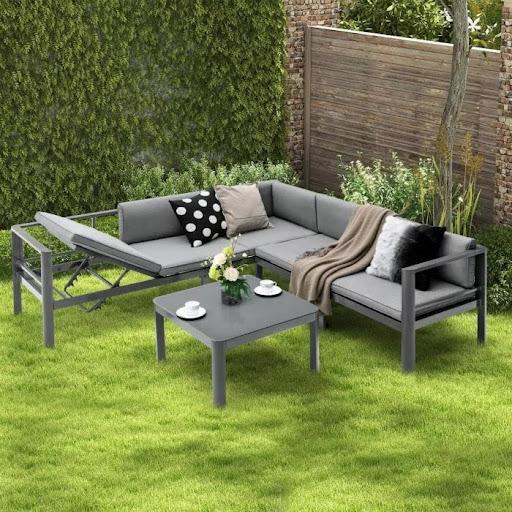
Additionally, aluminium furniture boasts inherent waterproof properties, making it suitable for all weather conditions without the need for additional treatments. Furthermore, many aluminium furniture pieces are coated with UV-resistant finishes, providing ample sun protection and preventing fading or discolouration over time. From sleek modern designs to classic styles, aluminum sofa sets with tables offer a wide range of aesthetic options to suit diverse preferences. While aluminium is recyclable, the process requires significant energy input, limiting its environmental sustainability compared to materials like wood.
Downsides of Aluminum
While aluminium furniture excels in many aspects, its downside lies primarily in its recyclability. Although aluminium is technically recyclable, the recycling process requires significant energy inputs, contributing to its environmental footprint. This aspect may deter environmentally conscious consumers seeking more sustainable options for outdoor furniture.
Final Verdict:
Aluminium emerges as an excellent choice for outdoor furniture, offering a balance of durability, affordability, and aesthetic appeal. While it boasts remarkable strength and resistance to the elements, its recyclability presents a drawback, as the recycling process requires significant energy inputs. Nonetheless, its durability and longevity mitigate environmental impact, earning it a sustainability rating of 4 out of 5.
3. Wicker/Rattan:
Rattan and wicker have long been favoured as outdoor furniture materials for their natural charm and versatility. While they offer a distinct aesthetic appeal, their durability can vary depending on factors such as climate and maintenance. Typically, natural rattan is not as durable as synthetic wicker, which is engineered to withstand outdoor conditions better. However, both materials require protective coatings or regular maintenance to combat moisture and UV damage, which can compromise their longevity. In terms of price, rattan and wicker chairs often fall within a moderate to high range, depending on the quality and craftsmanship.

Their lightweight construction enhances movability, allowing for easy rearrangement to suit changing outdoor settings. While not inherently waterproof, synthetic wicker treated with waterproof coatings offers improved moisture resistance. However, their susceptibility to sun damage requires periodic maintenance to preserve their appearance. On the eco-friendliness front, natural rattan is biodegradable and renewable, while synthetic wicker may not be as recyclable. Despite these drawbacks, rattan and wicker furniture continue to be popular choices for outdoor settings due to their timeless aesthetic and versatility in complementing various design schemes.
Downside of Rattan/Wicker
The primary downside of rattan and wicker furniture lies in their susceptibility to moisture and UV damage, which can compromise their durability over time. While synthetic wicker offers better resistance to outdoor conditions, both natural and synthetic materials require regular maintenance to prolong their lifespan, adding to the overall cost and effort of ownership.
Final Words:
Rattan and wicker furniture offer a unique blend of aesthetic appeal, versatility, and moderate durability for outdoor settings. While they require regular maintenance to withstand outdoor conditions effectively, their timeless charm and eco-friendly nature make them enduring choices for outdoor decor. I would rate rattan/wicker as outdoor furniture material 3.5 out of 5 for sustainability, with their renewable and biodegradable qualities being the standout feature that recommends them for eco-conscious consumers.
4. Powder-Coated Steel:
Rattan and wicker are enduring choices for outdoor furniture, prized for their timeless aesthetic and natural appeal. Their durability can vary depending on factors like climate and maintenance, with synthetic wicker often offering better resistance to moisture and UV damage compared to natural rattan. While the initial cost of rattan and wicker furniture may range from moderate to high, their longevity and classic style often justify the investment. Their lightweight construction enhances movability, allowing for effortless rearrangement to suit various outdoor settings.
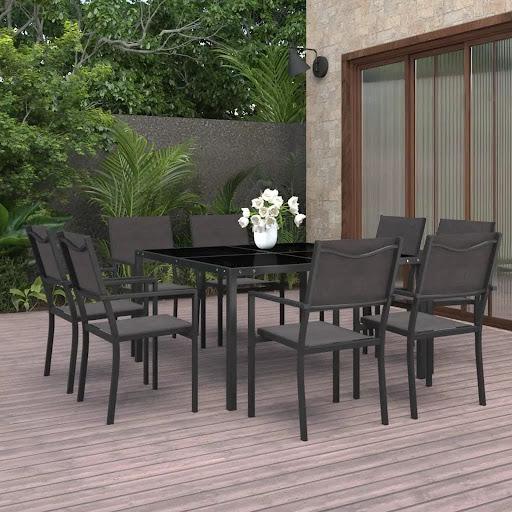
While not inherently waterproof, synthetic wicker treated with protective coatings can withstand moisture better, though both types may require occasional maintenance to preserve their appearance. Moreover, their recyclability may be limited, particularly for synthetic materials. Despite these considerations, rattan and wicker furniture continue to be popular choices for outdoor decor due to their ability to complement a wide range of outdoor aesthetics and add a touch of warmth and texture to outdoor spaces.
Downside of Rattan/Wicker:
Despite their charm and versatility, rattan and wicker furniture may require regular maintenance to combat moisture and UV damage, impacting their longevity. Additionally, their limited recyclability, especially for synthetic materials, can be a drawback for environmentally conscious consumers seeking more sustainable options.
Final Words:
Rattan and wicker furniture offer a blend of timeless charm, versatility, and moderate durability for outdoor settings. While they may require maintenance to withstand outdoor conditions effectively, their ability to complement various outdoor aesthetics makes them enduring choices for outdoor decor. I would rate rattan/wicker as outdoor furniture material 3 out of 5 for sustainability, with their renewable and biodegradable qualities being the standout feature that recommends them for eco-conscious consumers.
5. Polywood:
Pollywood, a blend of recycled plastic and hardwood, has emerged as a compelling choice for outdoor furniture, offering a unique combination of durability, eco-friendliness, and aesthetics. According to recent statistics, the global pollywood market is projected to witness significant growth due to increasing consumer demand for sustainable outdoor furniture solutions. Pollywood's durability rivals traditional materials like wood and metal, with the added advantage of being highly resistant to moisture, rot, and insect damage. Its price point is competitive, often lower than premium wood options, making it accessible to a wide range of consumers.

Polywood furniture is also lightweight, facilitating easy movability for hassle-free rearrangement or storage. Moreover, its inherent waterproof properties eliminate the need for regular maintenance, while UV-resistant finishes provide long-lasting sun protection. From sleek modern designs to classic styles, pollywood offers a diverse range of aesthetic options to suit various outdoor settings. Additionally, its recyclability makes it an environmentally conscious choice, contributing to sustainability efforts by reducing plastic waste.
Downside of Pollywood:
While pollywood boasts many advantages, its downside lies in its potential to fade or become brittle over time when exposed to prolonged sunlight or extreme temperatures. Additionally, while it is recyclable, the recycling process may not be as efficient or widely available compared to other materials.
Final Words
Pollywood stands out as a versatile and sustainable option for outdoor furniture, offering durability, eco-friendliness, and aesthetic appeal. Despite its drawbacks, its competitive price point and recyclability make it a compelling choice for environmentally conscious consumers. I would rate pollywood as an outdoor material 4 out of 5 for sustainability, with its eco-friendly composition and durability being the standout reasons to recommend it.
Conclusion:
In conclusion, while each material for outdoor furniture presents its own set of advantages and considerations, teak stands out as the recommended and arguably the best option for outdoor chairs and seats for garden furniture. Its unparalleled durability, natural resistance to weather elements, timeless aesthetics, and minimal maintenance requirements make it a top choice for outdoor spaces. However, it's crucial to weigh other factors such as price, movability, and environmental impact to ensure it aligns with your preferences and needs. By carefully evaluating these characteristics and considering your specific requirements, you can confidently select teak furniture that enhances your outdoor living experience for years to come.

